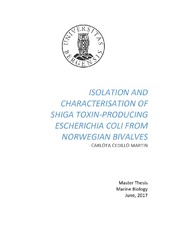Isolation and Characterisation of Shiga Toxin-Producing Escherichia Coli from Norwegian Bivalves
Abstract
Only few studies concerning Shiga toxin-producing E. coli (STEC) detection in coastal environments and bivalves have been reported and there have been no reported outbreaks by STEC from bivalves in the world. The aim of this thesis was to investigate the occurrence of STEC in Norwegian bivalves, and to characterize potential STEC isolates obtained from the samples. To improve our understanding of STEC, the occurrence was investigated in 269 bivalves collected from harvesting areas along the Norwegian coast in 2016/17. Microbial enrichment of the samples followed by DNA extraction with subsequent screening of STEC-associated genes was performed as described in ISO/TS -13136. Real-time PCR assays were conducted for genes encoding Shiga toxin (stx1 and stx2), intimin (eae) and the five major serogroups of concern (O157, O26, O111, O145 and O103). The screening results revealed the presence of the virulence genes (eae and stx) in 19 of the 269 samples. These 19 samples were selected for isolation of STEC. Colonies obtained from enrichment were screened for presence of stx and positive isolates were further characterized to determine their serotype and virulence profile. For two samples, automated immuno-magnetic separation (AIMS) was performed to facilitate isolation of STEC associated serogroups. Presumptive positive colonies from different serogroups were isolated by AIMS and the serogroup O157 was confirmed by real-time PCR but lacked the virulence genes. A total of three samples from 269 analyzed harbored STEC isolates, therefore, there seems to be a low risk of human infection by STEC in Norwegian bivalves.
